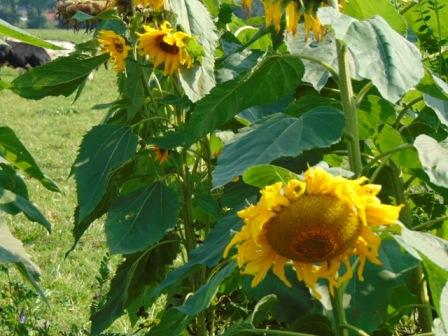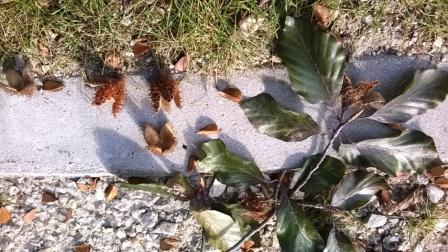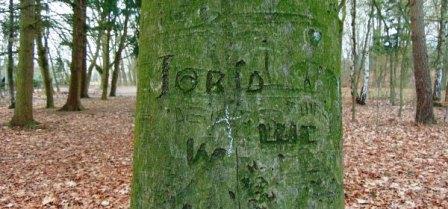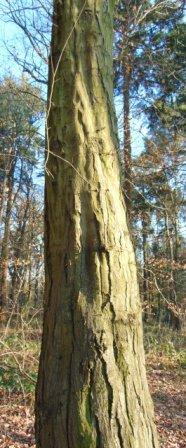Sunflower
 The sunflower (Helianthus annuus) is a one to three meters high, annual plant from the sunflower family (Asteraceae).
The sunflower (Helianthus annuus) is a one to three meters high, annual plant from the sunflower family (Asteraceae).
It grows easily everywhere, with variations from small to super with one or more flowers. The flower head may have a diameter up to 30 cm.
Adult sunflowers where the flower bud has not yet opened, exhibit heliotropism: on sunny days the flower bud follows the sun from east to west. At night he returns to the eastern state. Later stiffens the flexible segment (pulvinus) of the stem, and so the flower remains facing east.
Black seeds contain a lot of oil, and are suitable for pressing. Striped (and white) are used to eat, possibly roasted or ground. Or as nuts. (Yields of more than 1.000 kg / ha would be possible.)
If the seeds are easily visible (and the birds begin to pick them), you can harvest. Cut the flower with about 10 cm handle and hang them upside down to dry sheltered.
Germinated seeds with a range of up to 6 millimeters are also edible, e.g. on salads or sandwiches. Seeds with a longer spout taste bitter.
The seeds are in the flower according to a stunning visible structure with an arrangement in which both the Golden Mean and the Fibonacci Series are visible.
Shelling Sunflower 'seeds'
Sprinkle a layer of sunflower seeds in a bag or pillowcase. You can first dry or roast them (oven, stove), then the peel breaks easier. Role in two directions substantially with the rolling pin over them. Empty the bag in a bucket of water and scoop the lighter, floating skins off with the skimmer. Pour the water with the peeled seeds through the sieve. Drain well and dry.
Pine seeds
Seeds of some pines are edible. Pine nuts are extracted from conifers of the pine family (Pinaceae), genus Pinus. There are more than 100 species worldwide, many with edible seeds. In Europe, this mainly concerns the stone pine (Pinus pinea). Pine cones (or cones) will open in dry weather and then let loose their winged seeds. When it rains, the cones close to keep the seed dry so that they can fly farther. So if you want to reach the seeds, leave the cones dry (by the fire).
Some people keep very long a bitter, metallic aftertaste of eating the seeds.
F. Nouwen says in ’The last witness of WWI’ that also in his place, Westelbeers, in neutral Netherlands, people were hungry and starving. She used her clogs on her way to school to knock and break pine cones and to eat seeds.
Nuts Pine cones are short and thick, spruce cones long and conical.
Pine can be recognized by the needles in short shoots in bundles from two to five or more. The spar has each needle individually implanted. Mnemonic: Solo stands for Spar.
Beech nuts
 An beechnut is a small triangular nut, an achene, the fruit of the beech tree (Fagus Sylvatica). The pericarp is lignified like hazelnut, chestnut and acorn. The nuts are in a husk formed from the carpels and the bracts. In each wrap are two nuts. If the nuts are ripe the husk opens in four parts and the nuts fall out. They are spread by squirrels, which use it as winter stock. Previously, they were also fed as flour to the pigs.
An beechnut is a small triangular nut, an achene, the fruit of the beech tree (Fagus Sylvatica). The pericarp is lignified like hazelnut, chestnut and acorn. The nuts are in a husk formed from the carpels and the bracts. In each wrap are two nuts. If the nuts are ripe the husk opens in four parts and the nuts fall out. They are spread by squirrels, which use it as winter stock. Previously, they were also fed as flour to the pigs.
Beech nuts are also edible to humans (but are toxic in large quantities). You pick them up in October, November and December. In fresh nuts is a slight amount of hydrocyanic acid, better known as cyanide. Let the beechnuts a week to dry in a sunny spot, or roast them in the oven or in a saucepan. The poison then evaporates and nuts are really edible and less bitter.
Peeling is botch: 3 peeled nuts together weigh about 1 gram. That’s probably why they are not popular and underutilized.
 The word relationship between book and beech is attributed to the first bookings made, and beech letters and woodcuts by the invention of the printing press. Sometimes, it is believed that the smooth bark was used as bookfell, like paper. For this I found no evidence. By which smooth bark beech is the only tree that is used as a book. He is carved full of names, hearts and letters.
The word relationship between book and beech is attributed to the first bookings made, and beech letters and woodcuts by the invention of the printing press. Sometimes, it is believed that the smooth bark was used as bookfell, like paper. For this I found no evidence. By which smooth bark beech is the only tree that is used as a book. He is carved full of names, hearts and letters.
Because of its thin bark beech is sunburn sensitive, so he bends down its branches to protect (as he stands alone). The hornbeam you recognize especially to his muscular strain.
(hornbeam)

